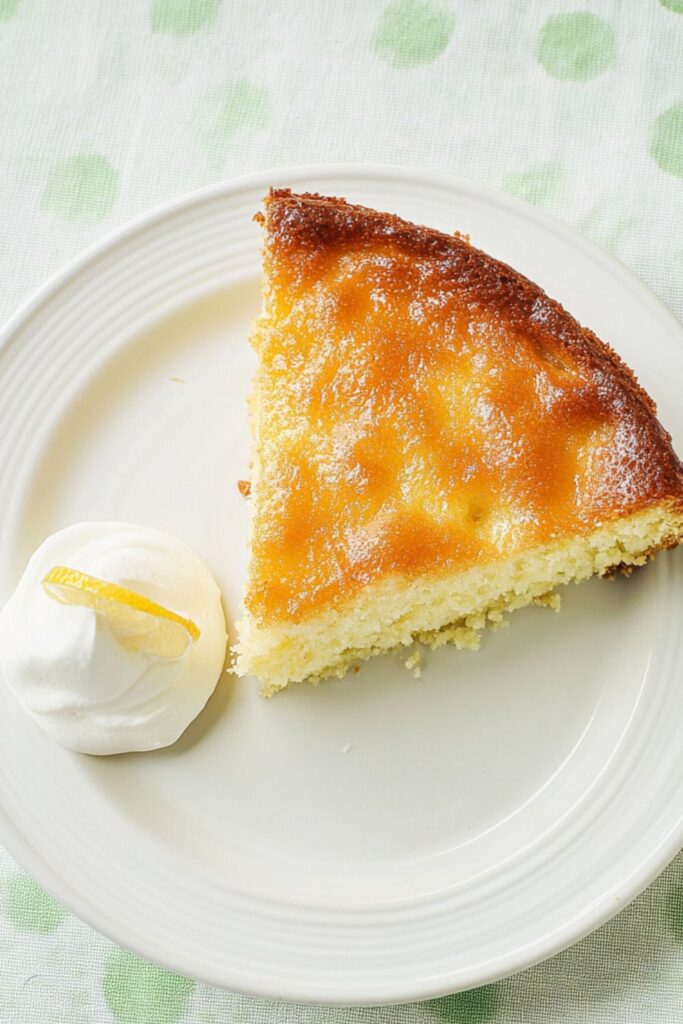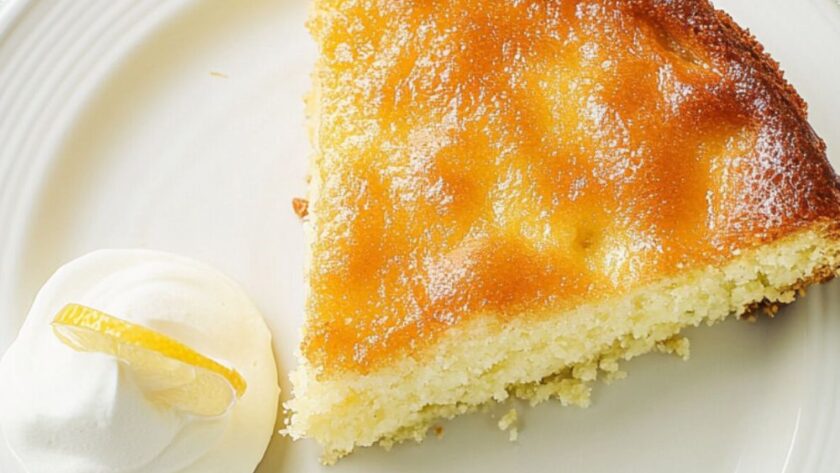This is the lemon cake I didn’t know I needed—until I baked it, let it cool just enough, and sliced through that crisp, crackly top. It’s got that perfect contrast: soft, tender sponge with the zingy crunch of sugar and lemon juice on top. Simple? Yes. But oh-so-clever.
The first time I made it, I got a bit impatient and poured the topping before the cake had finished baking. Mistake. It sank in, but the top lost all its crunch. Lesson learned: timing matters, and warm—not hot—is the sweet spot.
It’s the kind of cake that doesn’t need dressing up, but still manages to impress. Let me show you how to get that signature crunchy lemon finish just right.
Why This One Works So Well
- All-in-one method – No faff. Just dump, beat, bake.
- Lemon two ways – Zest in the batter, juice in the topping. You get fresh flavour and bold citrus punch.
- The sugar topping – It’s not just sweet—it sets into a delicate crust that cracks like toffee under your knife.
This is peak teatime territory. Ideal with a strong cuppa or light enough to serve after a meal.
Ingredients + Why They Matter
- Butter – Gives the sponge its richness. Room temp is essential for smooth mixing.
- Caster Sugar – Keeps the crumb light. Granulated can be too coarse for the sponge.
- Self-Raising Flour + Baking Powder – Extra lift without dryness. You need both to get that soft dome.
- Eggs + Milk – Binds the batter and loosens it just enough. The milk also softens the crumb.
- Lemon Zest – The oils carry more flavour than juice in the batter. Don’t skip this.
- Lemon Juice + Sugar (Topping) – This is where the magic happens. The sugar stays crunchy on top while the juice soaks just beneath the surface.
Making It Yours (Without Ruining It)
- Try orange or lime – I swapped the lemon for orange zest and juice once. Sweeter, but just as lovely.
- Add a poppy seed twist – Stir in a teaspoon of poppy seeds for texture and a nod to classic lemon-poppy bakes.
- Gluten-free? I’ve tested it with a good 1:1 GF blend. Cake’s a little more fragile, but the flavour holds strong.
- Dairy-free version – Use plant-based butter and non-dairy milk. You’ll lose a little richness, but the crunch makes up for it.
Mistakes I’ve Made (and How to Avoid Them)
| What Went Wrong | Why It Happens | How to Fix It |
|---|---|---|
| Topping sank in | Cake was too hot or underbaked | Wait 2–3 minutes after baking before topping |
| No crunch on top | Used icing sugar instead of caster/granulated | Stick with coarse sugar for texture |
| Cake stuck to tin | Skipped parchment | Always line the base, even if your tin is non-stick |
| Sponge was dense | Batter overmixed or ingredients too cold | Use room temp butter and eggs; beat just 2 minutes |
How to Make Mary Berry’s Crunchy Top Lemon Cake
- Preheat oven to 180°C / fan 160°C / gas 4. Grease and line the base of an 18cm deep round tin.
- Make the batter: In a large bowl, beat butter, sugar, flour, baking powder, eggs, milk, and lemon zest for 2 minutes until smooth.
- Bake for 35–40 minutes until risen, golden, and springy in the centre.
- Make the topping: Mix lemon juice and caster (or granulated) sugar in a small bowl.
- Add topping: As soon as the cake is out of the oven, prick the top with a skewer and spoon over the lemon-sugar mix. Let it soak and set.
- Cool in the tin. Once fully cool, remove from tin and serve.

Tips from My Kitchen
- I use a skewer to gently poke holes all over the warm cake before pouring the topping—it helps the lemon soak in just the right amount.
- Granulated sugar gives the most defined crunch, but if you prefer a subtler top, caster works too.
- If you want it extra lemony, add zest from a second lemon into the topping before pouring.
Storage + Serving
- Room Temp: Keeps for 3 days in an airtight tin.
- Fridge: Store up to 5 days for a firmer texture. Let it come to room temp before eating.
- Freezer: Wrap slices in cling film. Freeze up to 2 months. Defrost at room temp and enjoy.
Best served as is, or with a little mascarpone or crème fraîche if you want to be fancy.
FREQUENTLY ASKED QUESTIONS
Q: Why isn’t my topping crunchy?
A: You may have used icing sugar or added it too early. Wait a couple of minutes after baking, and always use caster or granulated sugar.
Q: Can I make it in a loaf tin?
A: Yes, a 1lb loaf tin works. Bake an extra 10–15 minutes and test with a skewer.
Q: Can I double it for a larger cake?
A: Absolutely. Use a 20cm or 23cm tin and increase baking time by about 10–15 minutes.
Q: Is bottled lemon juice okay?
A: Technically yes, but fresh juice makes a massive difference in both flavour and aroma.
Q: Why does my cake sink in the middle?
A: It could be underbaked or your raising agents are out of date. Always test the centre before removing from the oven.
Try Other Recipes:
- Mary Berry Round Lemon Drizzle Cake
- Mary Berry’s Apple and Lemon Sandwich Cake
- Mary Berry Lemon Victoria Sponge
- Mary Berry Lemon and Passion Fruit Cake
- Mary Berry Lemon Syllabub Recipe
Mary Berry Crunchy Top Lemon Cake
Course: CakesCuisine: BritishDifficulty: Easy8
servings10
minutes40
minutes270
kcalBright, Buttery Lemon Sponge With A Crisp, Tangy Sugar Crust—This One’S Pure Teatime Joy.
Ingredients
- For the Cake:
100g butter, softened
175g caster sugar
175g self-raising flour
1 tsp baking powder
2 large eggs, beaten
4 tbsp milk
Zest of 1 lemon
- For the Crunchy Topping:
Juice of 1 lemon
100g caster or granulated sugar
Directions
- Preheat oven to 180°C / fan 160°C. Grease and line an 18cm round cake tin.
- Beat all cake ingredients together for 2 minutes until smooth.
- Pour into tin, level, and bake for 35–40 minutes.
- Mix lemon juice and sugar.
- Pour topping over warm cake straight from the oven.
- Leave to cool in tin. Remove, slice, and enjoy.
Notes
- I use a skewer to gently poke holes all over the warm cake before pouring the topping—it helps the lemon soak in just the right amount.
- Granulated sugar gives the most defined crunch, but if you prefer a subtler top, caster works too.
- If you want it extra lemony, add zest from a second lemon into the topping before pouring.
